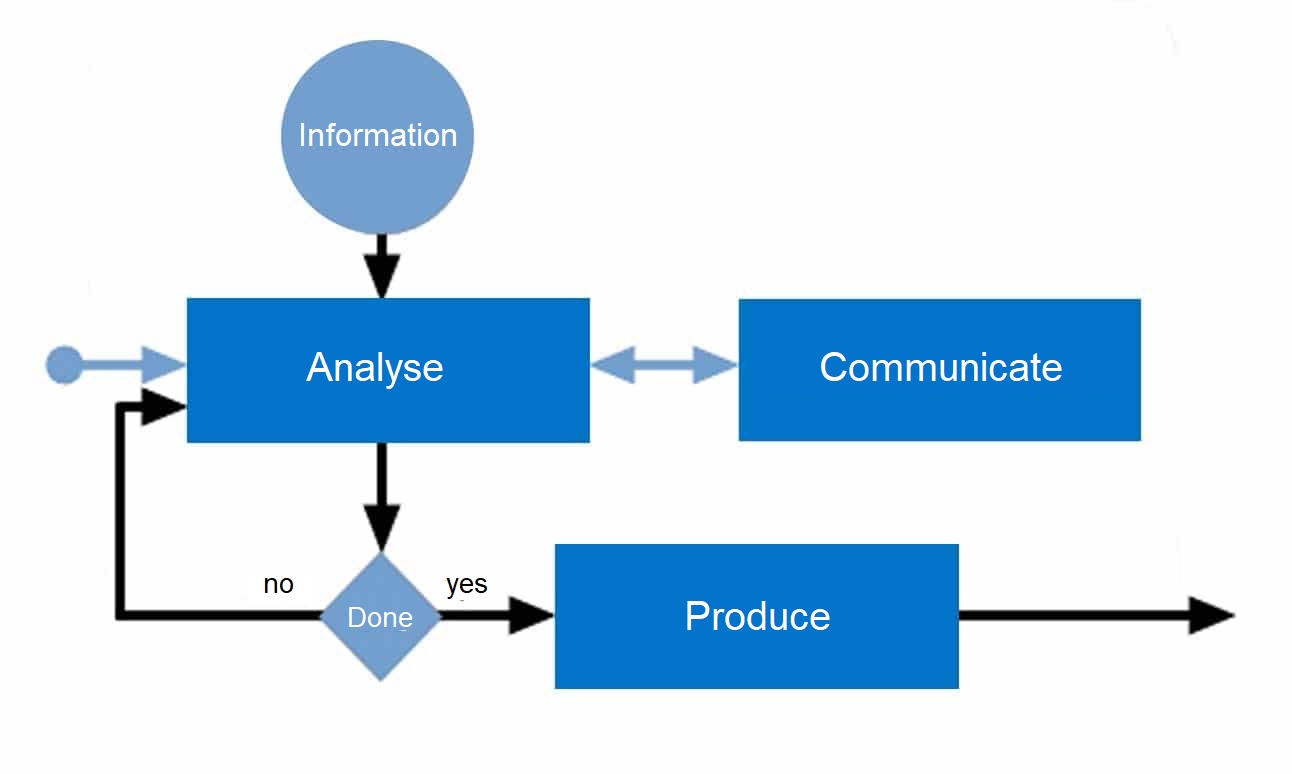IT analysis as a creative process
In 1926, it was Graham Wallas, the observations of Hermann von Helmholtz, a German physicist, and Henri Poincaré, a French mathematician, who combined them into a systematic theory of creative thinking.¹ According to this theory, creative thinking – similar to Archimedes’ pattern – takes place in four phases:
- Preparation: In the preparation phase you deal intensively with the problem, collect information and generate knowledge. Archimedes was concerned in this phase with the question of how to find out how much silver is in the crown.
- Incubation: In the incubation phase you let the information collected in the preparation phase sag. Do nothing, relax, take a bath or do something completely different. Don’t worry, your brain is still working to solve the problem.
- Illumination: In this phase comes the “eureka”. Your subconscious has done its work. The elements you collected in the preparation phase are reassembled – and you become aware of the solution.
- Verification: There are quite a few flashes of inspiration, i.e. you also have to confront a flash of inspiration with reality. Can your solution really work or is there something wrong with it? It can be assumed that Archimedes also checked his flash of inspiration after the walk with various attempts, because in the end he owed the king a resilient solution.
Creative thinking in IT analysis
What can we learn from this for our work in IT analysis? Does creative thinking also take place in requirements engineering? Let’s take a look at the main activities of a requirements engineer formulated in the IREB-CPRE Exam curriculum²:
- Determine requirements.
- Documentation of requirements.
- Check and coordinate requirements.
- Manage requirements.
Do you see room for creativity in these activities? Identifying and documenting requirements does not sound like a creative process. However, conventional requirements engineering should not be wrong either, because it independently knows some creativity techniques such as brainstorming, brainwriting or braindumping. And yet – if you want to come up with creative solutions, then the process model of requirements engineering needs to be further developed. For this purpose, we propose an analysis process – we call it System Analysis 3.0 – with three activities:
- Analyse: A draft solution is created from the available information.
- Communicate: The analyst’s solution ideas are coordinated with the stakeholders and new information is added.
- Produce: The solution design is created with the artifacts required for development.

The process of System Analysis
Creative thinking in analysis
“Analyse” is the part of the process in which the available information is formed into a solution design. The first step in the Graham Wallas creativity process is preparation. James Webb Young divides this phase into two parts: collecting raw material and processing it.³
For example, an analyst will look at the following questions:
- What is the role of the subject? Why does it exist at all? And what are the interfaces to other subject areas?
- Which terms, definitions and objects are used?
- Where does the essential information come from and which other subject areas are based on information from other areas?
- How and according to which rules does a specific subject area function?
- What is the aim of the system to be designed?
Steve Jobs once said: “Creativity is just connecting things”. In the context of analysis, this means looking at information from different angles and combining it in a new way. The preparation in the analysis phase is a different approach than the determination of requirements. It is about the world of the field, its rules and functions. Various sources of information such as specialist books, documentation, publications or discussions with stakeholders help to build up knowledge. This knowledge is the raw material from which the system design is ultimately created. Of course, this should be done in continuous consultation with the stakeholders.
There will be problems when processing the raw material, wishes and statements of stakeholders will contradict each other, information cannot be combined as hoped. This is where incubation comes in. If a challenge cannot be solved despite detailed discussion, taking a break helps. The subconscious takes on the challenge while you can devote yourself to other activities.
After some time, your subconscious will come back – with completely new perspectives and ideas. The phase of illumination has arrived. Whether you want to separate gold and silver, design a new variant for a process flow or an optimized data model, it doesn’t matter. It is your wonderful moment, it is your brainwave. But can your flash of inspiration also be implemented? Is it technically possible, economically sensible? What do the stakeholders say? To find out this is the task of verification. Here the solution has to be made comprehensible.
Communication and production in IT analysis
“Communicating” is the second activity in our process. In contrast to conventional requirements engineering, it is understood to mean more than the “collection of requirements”. It describes the coordination of our ideas and solution approaches, the communication with stakeholders and also the further development of knowledge. After the “eureka” in the illumination phase, this phase is very important. If the coordination is successful, the third phase of the process begins: “production”. The draft solution is ready. Now the necessary artefacts are produced to implement the design, e.g. process descriptions, UI designs or data models.
Conclusion
IT analysis can also be a very creative process. It is an important basis for the development of new, innovative solutions. In order to make innovations in IT projects possible, the analysis has to do more than just the collection and administration of requirements. However, the prerequisite for this is that there is room for creative thinking in the IT analysis process. The approach we propose, we call it “Systems Analysis 3.0”, combines the requirements of stakeholders and the creativity process as described by Graham Wallas.
Notes:
[1] Wallas, Graham: The Art of Thought, New York 1926
[2] IREB Certified Professional for Requirements Engineering – Foundation Level – Lehrplan
[3]: Young, James Webb: A Technique for Producing Ideas, New York 2003
Josef Falk has published two more posts in the t2informatik Blog:

Josef Falk
Josef Falk is an IT analyst at SEQIS GmbH. Since completing his studies in business administration in Vienna, he has been designing solutions in a wide variety of specialist areas - and acting as an intermediary between the specialist area and IT development. During the analysis, he pays special attention to the degree of innovation. In addition to his project work, he is involved in the development of business analysis and is currently a member of the board of the Austria Chapter of the IIBA (International Institute of Business Analysis).

